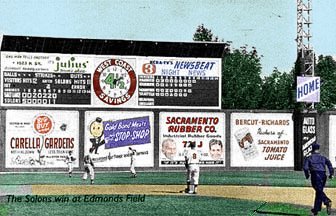 |
Edmonds Field
 |
Shortly before the 1944 season was scheduled to open, it looked like Sacramento might lose its baseball club. In early February, rumors began to circulate that the St. Louis Cardinals organization, which owned the Sacramento franchise, intended to sell it to a group in Vancouver, British Columbia. Seattle owner Emil Sick, who didn't welcome the competition, blocked that attempt exercising an option to purchase Vancouver's ballpark. But two days later, it was reported that another group in Tacoma had purchased the franchise. The Sacramento Chamber of Commerce reacted immediately by sending a letter to PCL President Clarence "Pants" Rowland requesting a delay in any action to move the team, and asking Cardinals President Sam Breadon how much he wanted to sell the team. Breadon responded that the franchise and players had already been sold to the Tacoma group for $50,000 but "if they care to relinquish the deal, I will make you the same offer."
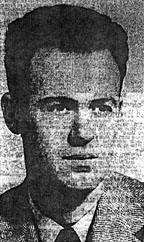 |
The owners of several of the other PCL teams, including Seals owner Charlie Graham, Oaks owner Clarence "Brick" Laws, and Padres owner Charles Lott, also opposed moving the Solons franchise to Tacoma. Accordingly, PCL President Rowland told the Sacramento Chamber of Commerce that the league would disapprove the move if a Sacramento group could put up at least $50,000 to buy the team by February 23.
After a drive to raise the money initially failed, Edmonds personally took up the cause. He first convinced a 28 year old grocery, liquor store, and night club owner named Yubi Separovich to invest $5,000. Then Edmonds and Separovich began contacting every potential investor they knew, and in the two days before the deadline they raised a total of $60,000.
Because of a record setting snowstorm on February 23, they arrived at the meeting of the PCL directors in Los Angeles three hours late, only to learn that the directors had already voted to approve the transfer to Tacoma. Edmonds and Separovich were nevertheless allowed to present their case, and the directors took a second vote to allow the team to stay in Sacramento.
After learning that the league would not approve the move, Tacoma dropped its claim, and Breadon finally agreed to sell the Sacramento group the ballpark for $50,000 and the franchise and players for $40,000. The Sacramento Baseball Association was immediately incorporated, selling stock for $50 a share. The original contributors became the first Board of Directors.
The efforts of Edmonds and Separovich did not go unrecognized. Yubi Separovich was named the first general manager of the Sacramento Baseball Association, at a salary of $5,000 per year. That winter, Edmonds contracted viral pneumonia and succumbed to the illness six months later in July of 1945. In the three weeks before the close of the 1945 season the Sacramento Junior Chamber of Commerce gathered the signatures of more than 5000 local fans on a petition to change the name of Doubleday Park to Edmonds Field. The directors of the Sacramento Baseball Association immediately approved, and on September 9, 1945, between games of a double header, Dick Edmonds was honored by having the ballpark at Broadway and Riverside renamed after him.
Shortly before midnight that night fire battalion chief Larry Mangan had just finished a root beer at the drug store next to the Tower Theater just up the street at Broadway and Land Park Drive. As he walked out, over his left shoulder he saw smoke billowing into the air. It was obvious where it was coming from -- Edmonds Field. He called in the alarm on his car radio, and hurried to the ballpark, where he began fighting the fire with a garden hose. At first, he thought he could beat it, but then "it began ripping and it beat me back. I couldn't lick it."
The Solons played the rest of the 1948 season on the road. A new group of investors headed by Sacramento Mayor George Klump took over control of the franchise from Chicago attorney Oscar Salenger who had recently purchased 53 percent of the stock. The new owners promised to build a modern plant which would make any other city in the league envious. The low bid on the project was $229,000, plus $60,000 for painting and electrical work. Reconstruction of the ballpark began in October. Although the league agreed to help finance the rebuilding the ballpark, it was rebuilt without league assistance in time for the start of the 1949 season.
The new Edmonds Field was entirely different from the old one. The wooden structure with large roof over the grandstand and covered bleacher section in the left field corner was replaced by a gray concrete structure with no roof anywhere. The left field bleachers, lights, scoreboard and advertizing signs in the outfield had not been destroyed, so that the fans in the stands looking toward the field had some feeling of familiarity with the new facility.
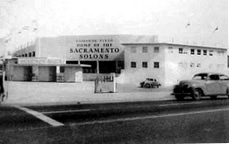 | 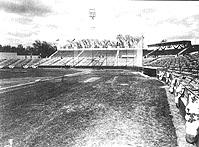 |
Edmonds Field was the home of the Solons for another eleven years. After reporting a loss of $113,000 for the year, in 1958 the team owners announced that they were considering either selling the franchise or selling the field and leasing it back from the buyer for a period of up to two years. As in 1944, the Sacramento Chamber of Commerce sought to come to the rescue with a fund raising drive. The team finished the 1959 season in a respectable fourth place, but attendance dropped. In 1960, the team finish sixth, the franchise lost $100,000, and its assets were reduced to almost nothing.
The fund raising drive did not meet its goal, and on November 14, the shareholders voted to accept the board of directors' decision to sell the franchise. On December 15, the league bought the franchise and sold it to the owner of the Salt Lake City Bees and a Salt Lake City banker. The teams only other assets were sold to the new Hawaii team.
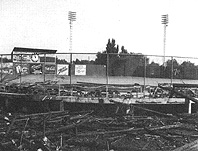 |
| HOME |
Copyright © 2003. William B.Shubb.